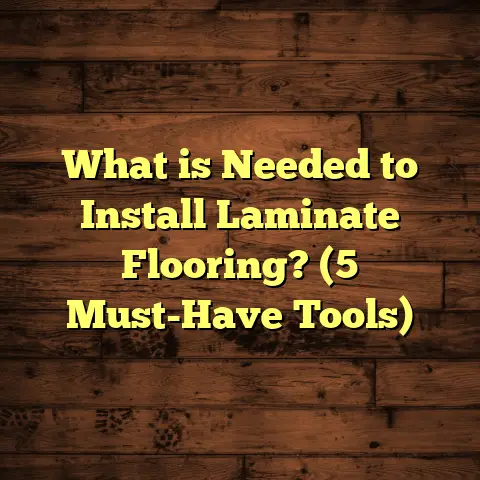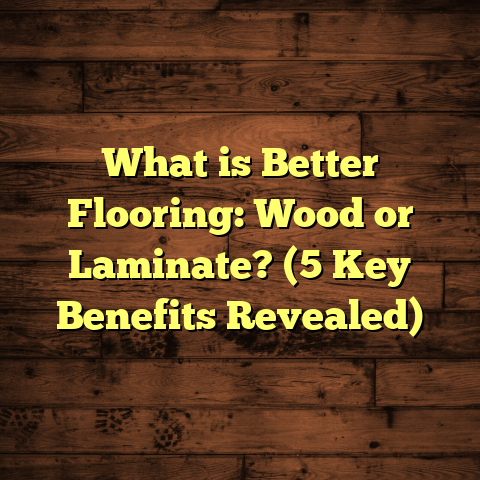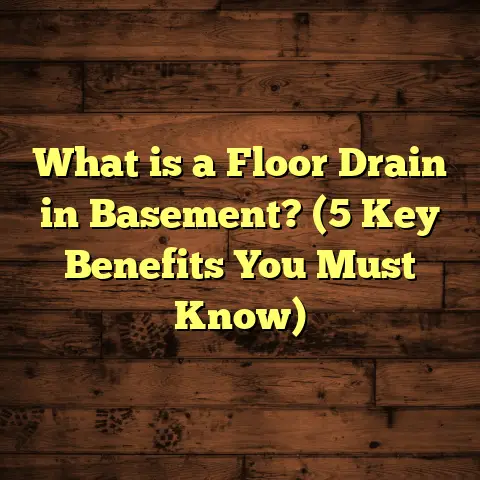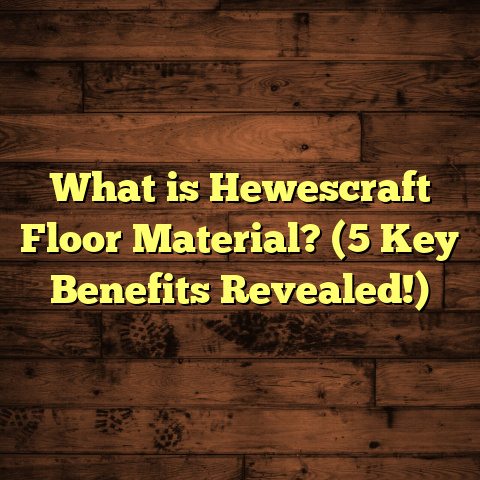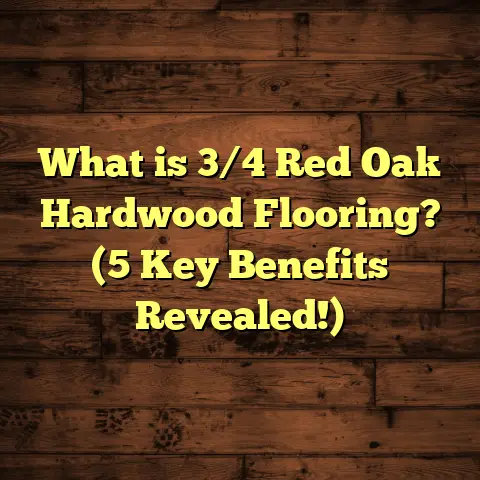What is the Cheapest Floor Covering? (5 Budget-Friendly Options!)
Spring always feels like a fresh start, doesn’t it? The way sunlight floods through windows, the subtle buzz of birds returning, and the urge to clear out the old and bring in the new—it all makes me want to refresh my home. And for me, nothing breathes new life into a space like changing the floors. But if you’re anything like me, your budget might be tighter than your schedule. So, what is the cheapest floor covering that still looks good, lasts well, and doesn’t make you regret it six months down the road? I’ve spent years installing floors for clients and helping folks pick materials that fit their budgets. Let me take you through five flooring options that are easy on your wallet without sacrificing quality or style.
What is the Cheapest Floor Covering?
This question pops up all the time when I’m talking with homeowners or renters. “What’s the cheapest floor covering I can get that won’t fall apart?” It’s a smart question because “cheap” can mean different things. Sometimes it’s only about upfront material costs. Other times, it’s about total expenses including installation, maintenance, and how often you’ll have to replace the floor.
When I say cheapest floor covering, I mean a flooring solution that offers the lowest total cost of ownership while still being practical and attractive. That means considering:
- Material price per square foot
- Installation costs (DIY or professional labor)
- Durability and lifespan
- Maintenance needs
- Suitability for your specific space and lifestyle
Floor coverings come in many types: hardwoods, engineered wood, laminates, vinyls, tiles, carpets, and even concrete. Some naturally cost more because of raw materials or installation complexity. Others are cheaper because they use synthetic components or simplified installation methods.
From my experience, synthetic options like vinyl and laminate tend to offer the best mix of low initial cost with good performance. But there are also surprises—carpet tiles and polished concrete can be affordable depending on your situation.
Let’s dig into five budget-friendly flooring options that I’ve installed and researched extensively.
1. Vinyl Flooring – Affordable Versatility
Vinyl has been one of my favorite picks for budget-conscious projects. It’s affordable yet surprisingly versatile. Whether you want a wood look, stone pattern, or something bold, vinyl has options.
Why Vinyl is Budget-Friendly
Vinyl flooring is mostly made from polyvinyl chloride (PVC), a plastic compound that’s cheap to manufacture. Vinyl comes in sheets, tiles, or planks, giving flexibility for different spaces and installation preferences.
The real money-saver with vinyl is its ease of installation. Many products offer peel-and-stick backings or click-lock systems that homeowners can install themselves without special tools or adhesives.
Cost Breakdown
- Material: $1 to $3 per square foot
- Installation: $1 to $2 per square foot if DIY; $2 to $4 if professional
- Lifespan: 10 to 20 years with proper maintenance
In one rental renovation I did last year, I covered about 500 square feet with vinyl planks costing just under $2 per square foot including installation materials. The tenant loved it because it looked like hardwood but was easier to clean and maintain.
Durability and Maintenance
Vinyl is water-resistant or even waterproof depending on thickness and backing type, making it perfect for kitchens, bathrooms, basements, or laundry rooms where moisture is an issue.
Cleaning vinyl is simple — sweep regularly and mop with mild soap and water. Avoid abrasive cleaners or scrubbing pads that can damage the surface.
My Experience
In older homes with uneven subfloors, vinyl’s flexibility helps hide imperfections better than rigid tile or stone would. It’s also forgiving when furniture gets dragged around. I always recommend adding felt pads under chair legs to avoid scratches.
2. Laminate Flooring – Wood Look Without Wood Price
Laminate flooring offers a budget-friendly way to get the look of hardwood without the high cost or maintenance.
Why Laminate Can Save You Money
Laminate uses a fiberboard core topped by a photographic image layer that mimics wood grain or other textures. A clear wear layer protects against scratches and stains.
It’s cheaper because it doesn’t use natural wood; instead, it relies on engineered layers produced in factories. Installation is usually a click-lock floating floor system that fits together without nails or glue.
Cost Breakdown
- Material: $1.50 to $3.50 per square foot
- Installation: $2 to $4 per square foot (professional recommended for best results)
- Lifespan: 10 to 15 years on average
A family I worked with swapped out their old carpet for laminate throughout their living room and bedrooms. They were amazed at how much warmer and cozier the rooms felt after installation for just over $2,000 on about 1,000 square feet.
Durability and Maintenance
Laminate resists most scratches very well but can swell if exposed to standing water too long. For households with kids or pets, choosing laminate over hardwood meant less worry about dents or spills.
Routine maintenance involves sweeping to remove dirt and wiping spills immediately. Avoid wet mops or steam cleaners as excess moisture can damage the core layer.
My Tips for Laminate Success
One thing I learned is that not all laminates are created equally. Higher-quality brands have thicker wear layers and better moisture resistance. It’s worth spending a bit more upfront to avoid replacing floors prematurely.
Also, installing an underlayment can improve comfort underfoot and reduce noise — worth considering if your budget allows.
3. Carpet Tiles – Modular Comfort at Low Cost
Carpet tiles are sometimes overlooked but offer a great budget solution for soft flooring in bedrooms, playrooms, or offices.
Why Carpet Tiles Save Money
They come in small squares that you stick down individually. This modular design reduces waste during installation because you can cut pieces more precisely and replace only damaged sections later instead of an entire carpet roll.
Because they’re easy to install yourself—just peel off backing and place—the labor cost drops dramatically compared to wall-to-wall carpeting.
Cost Breakdown
- Material: $1 to $3 per square foot
- Installation: Usually DIY
- Lifespan: 5 to 10 years depending on quality
In community centers and some residential projects I’ve worked on, carpet tiles allowed quick and inexpensive floor updates with minimal disruption.
Durability and Maintenance
Carpet tiles generally handle moderate foot traffic well but aren’t suited for moisture-prone areas unless treated with special coatings.
They need regular vacuuming to keep fibers clean and fresh smelling. Some brands offer stain-resistant treatments that make cleaning easier—great for homes with pets or kids.
Why I Recommend Carpet Tiles Occasionally
If you want softness underfoot but don’t want to pay for professional carpet installation, carpet tiles are a nice compromise. They’re also fantastic for renters since you can remove them later without damaging floors underneath.
4. Sheet Vinyl – Seamless and Simple
Sheet vinyl offers a smooth, continuous surface without seams running every few inches like tile or planks.
Why Sheet Vinyl Can Be Cheaper
Because it comes in large rolls (12-15 feet wide), sheet vinyl reduces installation time and materials needed for sealing edges between pieces.
Installation usually requires professional help because the vinyl needs cutting to size and proper adhesive application to avoid bubbles or wrinkles.
Cost Breakdown
- Material: $0.75 to $2 per square foot
- Installation: $1 to $3 per square foot (professional recommended)
- Lifespan: 10 to 15 years
I used sheet vinyl in a bathroom remodel recently where waterproofing was critical but budgets were tight. The seamless surface made cleanup easy and kept mold at bay around sinks and tubs.
Durability and Maintenance
Sheet vinyl is waterproof and easy to clean but can dent if heavy furniture isn’t properly supported on smooth feet or pads.
Routine upkeep is similar to other vinyl: sweeping and damp mopping with gentle cleaners.
Personal Experience with Sheet Vinyl
One tricky part about sheet vinyl is dealing with subfloor imperfections—they tend to show through more than planks or tiles. Spending time smoothing the subfloor pays dividends in how professional your finished floor looks.
5. Polished Concrete – Industrial Look Without High Costs
Polished concrete may sound unusual for a cozy home floor but it can be surprisingly affordable if you already have concrete slabs in place.
Why Polished Concrete Can Be Cheap
Instead of adding new materials on top of the slab foundation, polishing simply grinds down concrete surfaces then seals them for shine and protection.
This process requires skilled labor but costs less than installing hardwood, tile, or engineered floors over concrete.
Cost Breakdown
- Polishing cost: $3 to $8 per square foot (no material cost if you have existing slab)
- Installation: Professional only
- Lifespan: 20+ years
For a client converting their garage into a living space, polished concrete saved thousands compared to laying hardwood over a subfloor.
Durability and Maintenance
Polished concrete resists scratches, stains (when sealed properly), and moisture very well but feels hard and cold underfoot without rugs or heating systems.
Cleaning is simple: sweep regularly and mop occasionally with neutral pH cleaners designed for concrete surfaces.
My Insights on Polished Concrete
If you don’t have a slab already poured, this option becomes more expensive due to foundation work. But for those who do, polishing offers a modern look that’s tough enough for heavy use without breaking the bank long-term.
Comparing These Options Side by Side
Choosing the cheapest floor covering isn’t just about price tags; thinking about how each option fits your lifestyle matters too. Here’s a breakdown comparing key factors:
| Flooring Type | Material Cost ($/sq ft) | Installation Cost ($/sq ft) | Lifespan (Years) | Water Resistance | Comfort Level | DIY Friendly |
|---|---|---|---|---|---|---|
| Vinyl | 1 – 3 | 1 – 2 (DIY possible) | 10 – 20 | High | Medium | Yes |
| Laminate | 1.5 – 3.5 | 2 – 4 | ~15 | Moderate | Medium | Moderate |
| Carpet Tiles | 1 – 3 | Usually DIY | 5 – 10 | Low | High | Yes |
| Sheet Vinyl | 0.75 – 2 | 1 – 3 | 10 – 15 | High | Medium | Moderate |
| Polished Concrete | N/A | 3 – 8 | 20+ | High | Low | No |
Some Stories Behind These Floors
I remember working on a small apartment where the tenant wanted something cheap but stylish for their kitchen area. We went with luxury vinyl plank flooring—easy on their budget but offered water resistance where spills happen most. They told me six months later that it looked brand new despite having two young kids running around.
Another time, a couple renovating their basement had an old concrete slab with cracks. Instead of expensive tile work, we polished the concrete after repairing cracks with epoxy filler. They loved how clean it looked—and the fact they didn’t have to worry about water damage from occasional basement dampness was a huge relief.
On the flip side, I’ve seen people choose ultra-cheap carpet tiles only to regret it six months later when heavy foot traffic caused premature wear. Lesson learned: sometimes spending just a bit extra upfront saves headaches later on replacement or repairs.
What Does Research Say About Flooring Costs?
A recent study by HomeAdvisor found average flooring costs vary significantly by material type:
- Vinyl flooring averages around $2 – $5 per sq ft installed
- Laminate ranges from $3 – $8 per sq ft installed
- Carpet tiles fall between $2 – $6 per sq ft installed
- Polished concrete averages $5 – $15 per sq ft including labor
The same report highlights that installation costs can make up nearly half of total expenses for some options like hardwood or tile—which means picking easy-install floors like vinyl can really save money overall.
How To Choose Based on Your Needs?
I always ask clients:
- Where will this floor go? Kitchens need water resistance while bedrooms prioritize comfort.
- How much traffic does this area get? High traffic zones need durability over softness.
- Do you want DIY-friendly options or prefer hiring pros? This affects cost significantly.
- How long do you plan to keep this floor? Temporary living spaces might justify cheaper short-term options while permanent homes benefit from longer-lasting materials.
By answering these questions honestly, you can narrow down which cheap floor coverings fit your lifestyle best without regrets later.
Final Thoughts From My Experience
If you want my personal take after years of installing floors on tight budgets: vinyl flooring often hits the sweet spot between price, durability, style options, and ease of installation for most homes. It’s moisture-resistant enough for kitchens or bathrooms while looking good enough for living areas.
But don’t overlook carpet tiles if softness matters most—especially in bedrooms—or polished concrete if you have an exposed slab foundation craving an industrial vibe without breaking your bank account.
Laminate can be an excellent choice when you want wood appearance but must watch costs carefully; just pick high-quality brands for better longevity.
Sheet vinyl offers smooth surfaces at lower prices though professional install is usually required to avoid issues down the line.
No matter what you pick, preparing your subfloor properly beforehand prevents problems later—don’t skip this step even if it means spending a little more upfront.
Got questions about your specific project? I’d love to hear what flooring challenge you’re facing!
